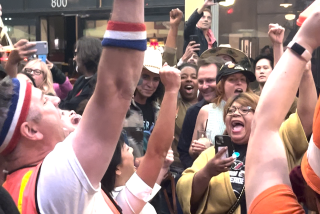NFL PLAYERS STRIKE: THE AFTERMATH : COMMENTARY : Owners Stronger When Push Came to Shove
- Share via
The next time a sports union considers going out on strike -- if indeed any of them consider such folly in the future -- they ought to reflect on what happened to the National Football League Players Assn., and remember this cardinal rule: If you can’t shut it down, don’t go out.
The NFLPA’s position eroded so rapidly, Gene Upshaw was up to his waist in water before he ever got to the bargaining table. Blessing the players’ return to work Thursday was symbolic. Considering the stampede of union members across the picket lines, Upshaw would’ve been trampled had he tried to stand firm.
The owners held tight and bent the players to their will, reeling them in, spanking them as if they were foolish children. “Now go to your room and don’t come out until you’re called.” What turned the strike was the players’ diminishing sense of solidarity and predictable reversion to individualism. When he crossed the line, Lawrence Taylor said something about having tried “this unity thing” and finding it wasn’t as important as the money he was losing. The romance of “this unity thing” stretches just so far. The money being lost was dearer to the players than the owners.
The owners’ position was immutable. They were on a mission to regain control of the product. They were in for the duration.
The union position was handicapped by a convergence of inhospitable trends and strategic miscalculations:
There was no competitive league so players could not threaten to take their services elsewhere. Players can thank the USFL for catapulting the average NFL salary more than $100,000 since 1983 when the USFL was formed. Ironically, had the USFL survived there surely would have been no strike as NFL owners would have been too fearful of losing fans and players to the rival league. As it is, the union was up against a powerful monopoly that was itself subsidized by the major television networks.
The players were undercut by an increasing anti-labor sentiment nationwide fueled by the Reagan Administration, demonstrably anti-union as the sacking of PATCO attests. Not only is the American union worker under fire, but many of those workers themselves found it difficult to sympathize with the plight of football players whose average salary was $230,000. Paradoxically, the good fortune pro players enjoyed while the USFL existed pushed them beyond the ken of the brotherhood of workers.
Striking players went to the barricades without a passionate issue to rally behind, an error. Mere days into the strike, players were saying they didn’t know why they were out. The owners propped free agency up as a straw man, then refused to bargain until the union dropped it. Outfoxed, the union was reduced to posturing about an issue a majority of its members had no zeal for. The owners agreed where they stood on free agency: It terrified them. Twenty-seven would spend their money stupidly, and Al Davis would use the rule to cane them.
The propaganda battle was no contest. The players allowed themselves to be saddled with the image of overpaid, overindulged brats with no real love for the game that patronized their luxuries. Public sentiment was overwhelmingly with the owners and the replacement players, who were seen as plucky and, in contrast to the strikers, as representative of a decent, honorable value -- starting at the bottom and working your way up.
What the union might have done is explain that players have prepared their whole lives for a career that on average lasts less than four seasons and pays less than $600,000 total. Contrast that with the typical professional -- a lawyer, accountant or physician -- who might earn more than $3-million over the course of his career. In that light, the case for pensions, severance pay and even free agency becomes more realistic.
The owners were more prepared for a strike than the players; they wouldn’t be closed down like in 1982. They had in Jack Donlan a professional negotiator who’d already busted one union. They had a clear strategy, including a plan not to negotiate so they could unveil the masterstroke of Scab Ball and prove to the players that they were, indeed, replaceable. Even to the end, the owners insisted the players come back on management terms or not at all. Stay out forever. Who needs you?
On the other side the players -- most of whom don’t dare negotiate their own individual contracts -- had a chief negotiator who prepared for the job by being an offensive guard. If you wanted to buy a fur, would you go to a microwave salesman?
For so many reasons, it was the wrong time for the players to strike.
“But what choice did we have?” Rich Milot asked. “The agreement was up. It was the only time we had.”
For a while it looked like the players had a chance if the public rejected Scab Ball by not watching on TV. Ratings faltered, but didn’t swoon. And the more players who crossed the line in search of a new fur-lined Rolls, the more determined, the more smug the owners became. Not letting the real players play this Sunday can only be interpreted as an act of woodshedding, a further humiliation of the errant child by the stern, strutting parent.
A few weeks ago, the day of the Redskins-Cardinals game -- a day of optimism for the union -- Milot stood shoulder to shoulder with striking teammates near the main gate at RFK, signing autographs and explaining the union’s position to all who cared to hear. But in a quieter tone, he addressed the apprehension that it all might fall apart, that the players might not have the patience for a long, cold night. “If we hang Gene out to dry,” Milot said prophetically, “then we’ve got no gripe about anything that happens to us. Because it’s us who did it. We caved in.”
Most of all, the owners’ advantage was that the players -- unlike most union members -- love their work, because it really is play. They don’t want to be on strike. They want to play football.
When push comes to shove, it isn’t the size.
It’s the leverage.
More to Read
Go beyond the scoreboard
Get the latest on L.A.'s teams in the daily Sports Report newsletter.
You may occasionally receive promotional content from the Los Angeles Times.










